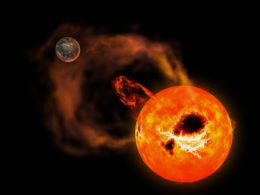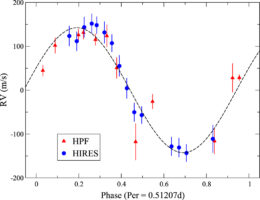Indirect detections of exoplanets rely heavily on the properties of their host stars. However, stellar features can sometimes masquerade as planetary signals. This issue is especially prominent for M dwarfs. So how do we know for sure if we’ve found a planet around an M dwarf?
Starring M Dwarfs
Despite the observational challenges they pose, M dwarfs present exciting prospects for exoplanet science. With their low masses, they are especially susceptible to the gravitational influence of any orbiting planets. When an M dwarf is tugged on by an orbiting planet, this affects the star’s radial velocity, creating a strong Doppler signal that we can detect in its spectrum.

The extent of the habitable zone (highlighted in green) for A stars, G stars, and M stars. As indicated in the figure, the Sun is a G star. [NASA]
But there’s a catch! While planets can produce detectable Doppler signals, so can M dwarfs themselves. Starspots, or cool regions on the surface of stars, can be prominent in the stellar spectra, and as an M dwarf rotates, starspots can mimic the effects of a planet.
So what’s to be done? M dwarfs are complicated beasts, so astronomers have been attempting to characterize them in more detail. In a new study, a group of researchers led by Paul Robertson (The University of California, Irvine) used optical and near-infrared observations of M dwarfs to understand the effects of starspots and other surface features.

An artist’s impression of an M dwarf flaring like AD Leo was observed to do so earlier this year. However, AP Leo is not confirmed to host any planets. [National Astronomical Observatory of Japan]
Spinning Around and Around
For their study, Robertson and collaborators selected four rapidly-rotating M dwarfs. Here, “rapid” means the rotational speed at the surface of the star is about 3 to 11 kilometers per second. Three of the stars in the sample were chosen because they were similar to the fourth, AD Leo. AD Leo is only 16 light-years from the Earth and has been studied extensively in the context of its magnetic activity, flares, and starspots.
Robertson and collaborators pulled observations from a number of instruments, including the Transiting Exoplanet Survey Satellite and the HARPS Spectrograph. They also used data taken by the Habitable-zone Planet Finder on the Hobby-Eberly Telescope, which was built especially for finding low-mass planets around M dwarfs.
Separating Out Planetary Signals

The phased radial-velocity/Doppler signals from the M dwarf GJ 3959 as observed by the Habitable-zone Planet Finder (HPF) and the High Resolution Echelle Spectrometer (HIRES). The phased signal represents a stacking of the observations based on the rotational period of GJ 3959, which is about half a day. [Robertson et al. 2020]
These findings contain a blessing and a curse for exoplanet searchers. Any planets whose orbital period is similar to the rotational period of the star will be very hard to distinguish. The longevity of the signals means it’ll likely be a long wait for the surface features to die out so we can verify if a planet was contributing to the signal. However, since the Doppler signals are stable and fairly predictable, they could be modeled and removed.
This study highlights the challenges of searching for planets around M dwarfs. But the finds would definitely be worth the trouble!
Citation:
“Persistent Starspot Signals on M Dwarfs: Multiwavelength Doppler Observations with the Habitable-zone Planet Finder and Keck/HIRES,” Paul Robertson et al 2020 ApJ 897 125. doi:10.3847/1538-4357/ab989f
